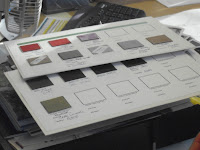
Today we went to Browick Infant school in Wymondham high school. When we got there we did our performance straight away. Because of the snow a few people couldn't get to school so Ryan had to do Bradley's part, i had to do Hollie's part and Mrs Haythorpe had to do my part. It didn't go very well because we didn't rehearse together and we had to improvise most of it but the Children got the idea. After the performances us three groups went into a class each and did workshops with them. In our workshop Ryan and Beth was meant to lead but Beth wasn't there and Sam wanted to lead so he led. The first thing we did was the opposites game, if Sam said hip then they had to say hop and hop, if Sam said Salt then they had to say pepper and put their hands above their heads. The second activity we did was me and Vickey had to pretend to fight over a pot of pens and the Children had to shout freeze when they think we did something wrong. Then they had to tell us what we did wrong and tell us what we should've done instead. After, the children got into groups of seven and all of us had to go with a group and they had to perform their own version of sharing. Afterwards some of them performed to each other. When they all did that they all went to the tables and drew what they thought sharing looked like. We took to drawings back so we could upload it onto our blogs. Then we all went back to Wymondham High. I think that a few things didn't go to plan but it did go faily successful. Our performances didn't go very well but they did get the message and when Sam asked who donates to charity and who buys from charity nearly all of them put thier hands up, and in the workshops all of them got the idea of sharing. I don't think the campaign has been successful with donations because it's nearly Christmas and people don't have much money to donate and people at high school probably don't really have any toys to donate because they might of donated them before. Our target audience is everyoine and i think that we could get them donating by making charity shops more modern and suitable for all ages. Usually only elderly oy young children go to charity shops. To promote our campaign we could put up huge posters and we could hold concerts or have a fair or something like that. To promote it, we could have a tv ad and put up posters and give out leaflets.
On our blogs we have to include in our blogs.
- Reflect on TIE performance
- Workshops
- Success - raising awareness profile of charity shops - donations
- Use Q's you asked and use 'data'
- Use photo's and annotations
- Use Video
- Why hasn't campaign been successful with donations.
- Pictures - children's
Letter to charity shops informing them of what you have done.








